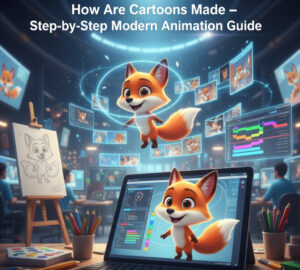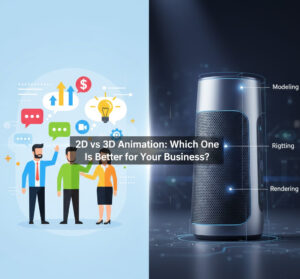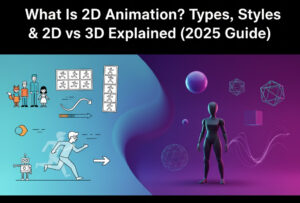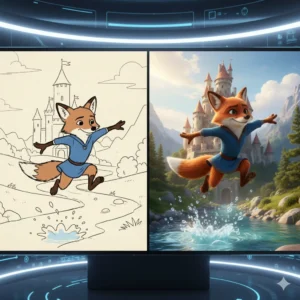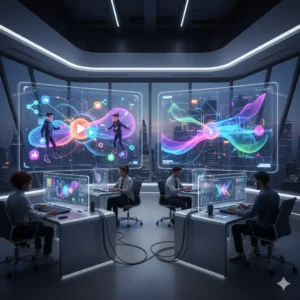Animation is no longer just for cartoons. Today, it drives marketing campaigns, online courses, and even personal branding. If you’ve ever wondered how to create animated videos, you’re in the right place.
This animated video guide takes you from beginner basics to advanced techniques. You’ll learn the core animation basics and how to apply them in real projects.
Why does it matter? Because audiences today expect engaging content. Studies show that video consistently ranks as the most consumed format online. Animated video stands out even more, offering flexibility and creativity that live-action often can’t.
Businesses use it to explain products. Teachers use it to simplify lessons. Creators use it to tell stories on social media. Whether you’re building a startup or teaching an online class, animation has a role in your strategy.
What Are Animated Videos?
Animated videos are visual stories created by moving graphics, drawings, or models. Instead of filming real people or objects, animators design elements that come alive on screen.
They can be simple or highly complex, depending on the style and purpose. Let’s look at the most common types of animated videos used today:
- 2D animation – Classic flat-style characters and scenes, often used in explainer videos.
- 3D animation – Adds depth and realism, popular in films, product demos, and architecture.
- Motion graphics – Animated text, shapes, and icons, ideal for presentations and brand videos.
- Whiteboard animation – Hand-drawn illustrations appear on a white background, great for tutorials.
- Stop-motion – Real objects photographed frame by frame to create movement.
Each style serves a unique purpose. For example, explainer animation is perfect for startups trying to introduce a product. Motion graphics examples often appear in finance or tech to simplify complex data.
You can read more about animation’s origins and evolution on Wikipedia: Animation.
The important takeaway? Animation isn’t one-size-fits-all. The right style depends on your audience, industry, and message.
Why Animated Videos Are Powerful in 2025
The demand for animation is booming. According to Statista, online video consumption grows every year, with over 3.5 billion digital video viewers worldwide in 2025. Forbes also highlights that video content delivers higher engagement and retention than text or images alone. So, your search for How to Create Animated Videos is not a bad decision.
So, why are animated videos gaining such traction?
- Flexibility: Unlike live-action, animation isn’t limited by actors, locations, or budgets. A single designer can create entire worlds.
- Engagement: Viewers are 80% more likely to finish an animated explainer video compared to reading a product brochure.
- Clarity: Animation simplifies complex ideas. A financial company can use motion graphics to explain markets in ways live-action can’t.
- Cost-effectiveness: While professional live-action requires sets and production crews, animation tools make it easier to create from anywhere.
Businesses rely on animated videos for business marketing because they work. Animated ads on social platforms deliver higher click-through rates than static content. Educators use animated explainers because they improve comprehension. Even personal brands benefit, using short animated reels to stand out in crowded feeds.
Another reason for growth is technology. Tools are evolving fast. AI-powered software now automates parts of the process, making production faster. These animation trends 2025 show no sign of slowing down, especially with the rise of VR, AR, and immersive learning content.
When comparing animated vs live-action videos, both have strengths. Live-action feels authentic for human storytelling. Animation shines when you need creativity, clarity, or global appeal. Together, they can form a powerful content strategy.
Want to see how animation adds impact to branding? Check out our insights on logo animation for ideas that boost recognition and engagement.
Beginner’s Guide: Getting Started with Animation
Starting with animation can feel overwhelming, but the good news is anyone can learn How to Create Animated Videos. You don’t need to be a professional artist or filmmaker. With the right tools and approach, you can build high-quality videos that grab attention.
So, where should you start? Let’s break it down.
Tools & Software for Beginners
The first step is choosing the right beginner animation software. There are both free and paid options, so you can start small and upgrade as your skills grow.
- Free Tools – Programs like Blender, Pencil2D, and Krita are excellent for testing the waters. They offer core features without a price tag, making them perfect for learners.
- Affordable Paid Options – Software like Vyond, Animaker, and Moovly make it easy to create animated explainers. Their drag-and-drop features are user-friendly and require no design background.
- Professional Software – Once you’re ready, programs like Adobe After Effects or Toon Boom Harmony provide advanced editing and motion tools. They’re powerful, but they take time to master.
The best approach? Start with something simple and move up as you gain confidence.
Learning the Basics
Software alone won’t make your videos stand out. To truly understand How to Create Animated Videos, you need to learn the core elements of storytelling.
- Scripting – Every great animated video starts with words. Write down your message in clear, short sentences. A script gives your project direction and flow.
- Storyboarding – Think of this as a comic strip version of your video. Sketch out scenes to visualize how the story unfolds. Even stick figures help clarify ideas.
- Voiceovers and Sound – Audio sets the mood. A good voiceover makes content more relatable, while music and sound effects add energy.
These basics will keep your project structured and engaging. Remember, animation is about clarity, not complexity.
Essential Steps to Create Animated Videos
Once you’ve got the tools and basics covered, it’s time to put everything together. Here’s the animation process step by step for anyone learning How to Create Animated Videos from scratch:
Define Purpose & Audience
Decide why you’re making the video and who it’s for. A product explainer for customers will look different than a classroom tutorial.
Write a Script
Keep it short and simple. Aim for sentences under 20 words. The script is your foundation, guiding visuals and timing.
Storyboard Scenes
Draw rough sketches of each scene. This helps you plan transitions and pacing before diving into software.
Choose a Style (2D, 3D, Whiteboard, Motion Graphics)
Select the look that fits your audience. For example, 2D animation works well for explainers, while 3D is great for product showcases.
Select Software
Pick your tool based on budget and goals. Beginners might use Animaker, while advanced users turn to After Effects.
Add Audio (Voice/Music)
Record a professional voiceover or use AI voice tools. Pair it with background music that matches the tone.
Animate & Edit
Bring your characters and graphics to life. Adjust timing, transitions, and effects until the video flows naturally.
Export & Publish
Save your final video in high quality. Then, upload it to YouTube, social media, or your website to share with your audience.
This structure works for all types of projects. Whether you’re making a 30-second ad or a 10-minute lesson, these steps guide you from idea to finished video.
And if you feel stuck at any point, don’t worry. The experts at Vozo Animation Contact can help you streamline production and create videos that look professional.
Advanced Techniques for Pro-Level Animation
Once you’ve mastered the basics of How to Create Animated Videos, it’s time to push your skills further. Pro-level animation requires a mix of creativity, technical detail, and industry tools. Let’s look at some professional animation techniques you can start using.
Camera Movement, Lighting, and Layers
Subtle camera shifts bring scenes to life. Instead of keeping everything static, pan across a background or zoom in on a character’s reaction. It mimics real film and adds depth.
Lighting is equally important. Good lighting creates mood, bright tones for playful ads, darker shadows for dramatic scenes. With digital tools, you can control highlights and reflections frame by frame.
Finally, learn to work with layers. Layers separate elements, backgrounds, characters, text, so you can edit independently. This makes your project flexible and keeps complex scenes organized.
Using Blender, Maya, and After Effects
Three software names dominate advanced animation:
- Blender – A free yet powerful tool for both 2D and 3D animation. Ideal for mixing styles and experimenting without big costs.
- Maya – Known as the industry standard for high-end 3D projects. Films, gaming, and advertising agencies often rely on it for realistic rendering.
- After Effects – Best for motion graphics and post-production. Think text animations, transitions, and special effects. It pairs well with other Adobe tools.
Learning these platforms takes time, but once you’re comfortable, your projects will look polished and cinematic.
Mixing 2D and 3D
One of today’s hottest advanced animation tips is blending 2D and 3D elements. For example, a flat character can walk through a 3D environment, creating a fresh hybrid style. It combines the charm of traditional animation with the depth of modern design. Brands love this look because it stands out in crowded feeds.
Best Software to Create Animated Videos (2025 Update)
Choosing the right tool matters. In 2025, options are more diverse than ever. Here’s a breakdown of the best animation software 2025, covering both beginner-friendly platforms and advanced solutions.
Beginner Tools
- Powtoon – Great for quick animated presentations and explainer videos. Drag-and-drop interface, but limited in customization.
- Vyond – A favorite for marketers. Easy character animation and voice sync make it strong for storytelling.
- Animaker – Affordable and loaded with templates. Perfect for social media clips or small business projects.
These animation tools for beginners make it simple to start without heavy learning curves.
Professional Tools
- Adobe After Effects – Still the go-to for motion graphics. Pricey, but integrates seamlessly with Photoshop and Illustrator.
- Blender – Free, open-source, and incredibly powerful. Best for creators on a budget who still want pro results.
- Maya – Expensive but unmatched in realism. Studios use it for full 3D productions and complex animations.
Pricing & Pros/Cons
- Powtoon/Vyond/Animaker – Affordable, quick setup, but limited in advanced editing.
- After Effects – Excellent for customization, but requires practice. Subscription model adds cost.
- Blender – Free, versatile, but the learning curve is steep.
- Maya – Best quality, but very expensive and requires high-end hardware.
The takeaway? Beginners should test Powtoon or Vyond. Professionals aiming for cinematic results should invest time in Blender or Maya.
Animation for Business & Marketing
Animation is more than art, it’s a powerful tool for growth. Today, brands invest heavily in animated explainer videos for business because they capture attention in seconds.
Marketers know animated content boosts engagement on social platforms. According to recent reports, video ads using animation outperform static graphics by more than 30% in click-through rates. Animation allows businesses to simplify complex ideas and make them memorable.
For example, a fintech company might use animation to explain mobile payments. Instead of dull charts, they animate coins, phones, and user journeys. Viewers understand faster and stay longer.
Case studies also prove results. One startup saw website conversions rise by 40% after adding an animated explainer video to their homepage. Another retail brand used short animated ads on Instagram and doubled traffic in two weeks.
Simply put, animation marketing works because it combines clarity with creativity. And if you want to elevate your business strategy, Vozo Animation Services offers tailored solutions that fit any brand.
Common Mistakes Beginners Should Avoid
Starting with animation is exciting, but mistakes can hold you back. One of the biggest animation mistakes beginners make is writing an overcomplicated script. A simple, clear message always works better than one packed with too many details.
Another issue is weak audio. Viewers forgive rough visuals, but bad sound drives them away fast. Invest in clean voiceovers and royalty-free music to keep your video professional.
Finally, many new creators choose the wrong style. Not every project needs 3D or flashy motion graphics. Pick the animation type that fits your audience and purpose, not just what looks “cool.”
Cost of Creating Animated Videos
So, how much does video animation cost? The answer depends on tools, time, and talent.
If you use free software like Blender or Animaker, your only cost is time. These tools are great for DIY projects but can take longer to master. Paid tools like Adobe After Effects or Vyond add advanced features but also monthly fees.
For businesses, the real cost question is DIY vs hiring a studio. A do-it-yourself video might cost less upfront but often takes longer and looks less polished. On the other hand, professional studios charge more, but the results drive higher engagement and sales.
When should you outsource? If your video needs to represent your brand at scale, like a product launch or corporate ad, professional work pays for itself. That’s why an animation pricing guide often shows higher returns when brands invest in quality. The cost of animated videos is really an investment in visibility and credibility.
| Type of Animation Project | DIY Cost (Using Software) | Professional Studio Cost |
| Short Explainer (30–60 seconds) | $0 – $200 | $1,000 – $5,000 |
| Marketing Video (1–2 minutes) | $50 – $500 | $3,000 – $10,000 |
| Detailed 2D Animation (2–3 min) | $100 – $800 | $5,000 – $15,000 |
| Advanced 3D Animation (1–2 min) | $200 – $1,000 | $7,000 – $20,000+ |
Future of Animated Videos
The future is brighter than ever for creators. New AI animation tools like Runway and Pika Labs are cutting production time in half. These platforms use artificial intelligence to generate realistic scenes, making animation faster and more accessible.
Trends also point toward immersive experiences. Augmented Reality (AR) and Virtual Reality (VR) will dominate the next decade. Imagine animated characters stepping into your living room or training simulations happening in 3D spaces.
Hyper-realistic 3D is another big trend. As rendering technology improves, animated videos look almost indistinguishable from live-action. This shift is already shaping entertainment, advertising, and education.
The future of animation videos will blend AI efficiency with human creativity, giving everyone, from beginners to pros, new opportunities to tell stories in bold, innovative ways.
Key Takeaways
Animation doesn’t need to be intimidating. You learned the basics of How to Create Animated Videos, explored pro-level tools, and even looked ahead at the trends shaping tomorrow. The journey from beginner to expert is simply about practice, patience, and the right resources.
Remember: anyone can start small. Even with free software, you can create something meaningful. As your skills grow, so will your options, from simple 2D explainers to cinematic 3D productions.
Conclusion
Learning how to create animated videos from beginner to pro is one of the most rewarding creative paths today. Whether you’re a student, business owner, or hobbyist, animation lets you share ideas in ways words alone cannot.
And if you’re ready to go further, don’t do it alone. Contact Vozo Animation today for professional help turning your vision into powerful, polished videos.
FAQs
What software is best for beginners in animation?
Tools like Powtoon, Vyond, and Animaker are easy for beginners. They offer templates and drag-and-drop features to get started quickly.
How much does it cost to make an animated video?
The cost of animated videos ranges from free DIY tools to thousands of dollars for studio-quality production. Your choice depends on budget and goals.
What are the most common mistakes beginners make?
Overcomplicated scripts, weak audio quality, and choosing the wrong style are top animation mistakes beginners make. Keep it simple and clear.
Are AI tools useful for animation?
Yes, platforms like Runway and Pika Labs speed up the process. These AI animation tools help creators generate professional-quality animations faster.
Why do businesses use animated videos?
Companies love animated explainer videos for business because they simplify complex ideas and boost engagement across social media and websites.
What’s the difference between DIY and hiring a studio?
DIY is affordable but time-consuming. Hiring a studio costs more but delivers polished, brand-ready animations that often perform better.
What are the top trends in 2025 animation?
Expect AR, VR, and hyper-realistic 3D to dominate the future of animation videos, making content more immersive than ever.

